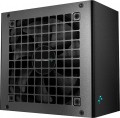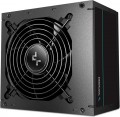Efficiency
Efficiency, in this case — the ratio of the power of the power supply (see "Power") to its power consumption. The higher the efficiency, the more efficient the power supply, the less energy it consumes from the network at the same output power, and the cheaper it is to operate. Efficiency may differ depending on the load; the characteristics can indicate both the minimum efficiency and its value at an average load (50%).
It should be noted that compliance with one or another level of 80PLUS efficiency directly depends on this indicator (for more details, see "Certificate").
Certification
The presence or absence of an 80+ certificate for the power supply. This certificate indicates high energy efficiency: to obtain it, the efficiency (see above) must be at least 80%, and in different modes (20%, 50% and 100% of the maximum load). There are several degrees of 80+:
—
80+. The original version of the certificate, assuming an efficiency of at least 82% (at least 85% for 50% load).
—
80+ White. The second name of the original 80+ certificate (see above).
—
80+ Bronze — efficiency not less than 85% (for half load — 88%).
—
80+ Silver — respectively 87% (90% for half load).
—
80+ Gold — 89% (92% for half load)
—
80+ Platinum — 90% (94% for half load).
—
80+ Titanium — 94% (96% for half load).
The power factor (see "PFC Type") must be at least 0.9 for the lower levels and at least 0.95 for the Platinum level. Also note that for redundant power used in server systems, the efficiency requirements are somewhat lower.
SATA
The number of SATA power connectors provided in the PSU.
Nowadays, SATA is the standard interface for connecting internal hard drives, and it is also found in other types of drives (SSD, SSHD, etc.). Such an interface consists of a data connector connected to the motherboard, and a power connector connected to the PSU. Accordingly, in this paragraph we are talking about the number of SATA power plugs provided in the PSU. This number corresponds to the number of SATA drives that can be simultaneously powered from this model.
MOLEX
The number of Molex (IDE) connectors provided in the design of the power supply.
Initially, such a connector was intended to power peripherals for the IDE interface, primarily hard drives. And although the IDE itself is completely obsolete today and is not used in new components, however, the Molex power connector continues to be installed in power supplies, and almost without fail. Almost any modern PSU has at least
1 – 2 of these connectors, and in high-end models this number can be
7 or more. This situation is due to the fact that Molex IDE is a fairly universal standard, and with the help of the simplest adapters, components with a different power interface can be powered from it. For example, there are Molex - SATA adapters for drives, Molex - 6 pin for video cards, etc.
PCI-E 8pin (6+2)
The number of PCI-E 8pin (6+2) power connectors provided in the PSU design.
Additional PCI-E power connectors (all formats) are used to additionally power those types of internal peripherals for which 75 W is no longer enough, supplied directly through the PCI-E socket on the motherboard (video cards are a typical example). In PC components, there are two types of such connectors — 6pin, providing up to 75 W of additional power, and 8pin, giving up to 150 W. And the 8pin (6 + 2) plugs used in power supplies are universal: they can work with both 6-pin and 8-pin connectors on the expansion board. Therefore, this type of plug is the most popular in modern PSUs.
As for the quantity, on the market you can find models
for 1 PCI-E 8pin (6 + 2) connector,
for 2 such connectors,
for 4 connectors, and in some cases —
for 6 or more. Several of these plugs can be useful, for example, when connecting several video cards — or for a powerful high-performance video adapter equipped with several PCI-E additional power connectors.
+5Vsb
The maximum current that the PSU is capable of issuing + 5Vsb to the power line.
For more information about power lines in general, see "+3.3V". Specifically, the + 5Vsb line is used to power the computer electronics in standby mode, when the main and only task of the system is to respond to pressing the power button. This does not require high power, so this figure rarely exceeds 3A.
+3.3V +5V
The maximum power that the PSU is capable of delivering on the + 3.3V and + 5V power lines.
See "Maximum current and power" for details on power lines in general. Here we note that the power lines + 3.3V and + 5V are used both in the general connector for the motherboard (for 20 or 24 pins), and in specialized plugs — in particular, the SATA power connector (both) and Molex (only +5V, in addition to +12V). The power of these lines is a rather specific parameter, rarely required in fact; it is usually the same for both voltages, so it is indicated in the general clause.
+5Vsb
The maximum power that the PSU is capable of delivering to the power line is + 5Vsb.
See "Maximum current and power" for details on power lines in general. Here we recall that the + 5Vsb line is used to power the computer electronics in standby mode, when the main and only task of the system is to respond to pressing the power button. This does not require high power, so this figure rarely exceeds 15 watts.
Protection
Protection circuits provided in the power supply. In addition to the OVP (overvoltage protection), OPP (overcurrent/power protection), and SCP (short circuit protection) described above, modern PSUs may include the following safety features:
— O.C.P. Overload protection on individual power outputs. It differs from OPP in that it takes into account not the total current consumption, but the current at each output separately.
— UVP. Undervoltage protection at the output of the power supply. For some components, such a voltage is as undesirable as an increased voltage: for example, a hard drive at reduced power cannot spin the plates to the required speeds. Usually, UVP is activated when the voltage drops by 20 – 25%.
— OTP. Protection against overheating of individual components of the power supply.
— SIP. Protection against voltage surges and surges is, in fact, a built-in stabilizer that can smooth out these surges to a certain extent. This feature does not eliminate the need for an external stabilizer, but it improves the overall performance of the protection.
— A.F.C. Not so much a protective as an “energy saving” function: automatic fan speed control, which allows you to change the speed depending on the load and the actual heat dissipation of the PSU. In addition to saving energy, this adjustment also reduces wear on the moving parts of the cooler.
— C.E. Power supply complies with European Union dire...ctives for energy efficiency and safety.
— CB. Power supply complies with IEC (International Electrotechnical Commission) directives regarding the safety of electrical equipment and components.
— FCC. Power supply complies with FCC (Federal Communications Commission) directives, especially regarding electromagnetic interference.
— CCC. Compliance of the power supply with the requirements necessary for official certification in the Chinese market (PRC).
— K.C. Compliance of the power supply with the requirements necessary for official certification in the South Korean market.
— BSMI. Compliance of the power supply with the requirements required for official certification in the Taiwan market.
— RCM. Power supply meets the requirements for official certification in the Australian and New Zealand market. RCM requirements are primarily concerned with safe use and electromagnetic compatibility.
— TUV-RH. Power supply meets the criteria for certification by TÜV Rheinland Group, one of the world's largest and most respected auditing and certification companies. Most often, we are talking about the TÜV-Mark Approval certificate, which indicates that the individual parts of the device (body, boards, parts, switches, etc.) comply with the requirements for safe use.
— cTUVus. Another certification held by the above mentioned TÜV Rheinland Group. In this case, we are talking about the compliance of the power supply with the technical requirements necessary for admission to the markets of the USA and Canada. The cTUVus certificate has the same legal validity as certificates issued directly by the authorities in those countries.
— EAC. Compliance of the power supply with the technical requirements of the Eurasian Economic Union (former Customs Union).

